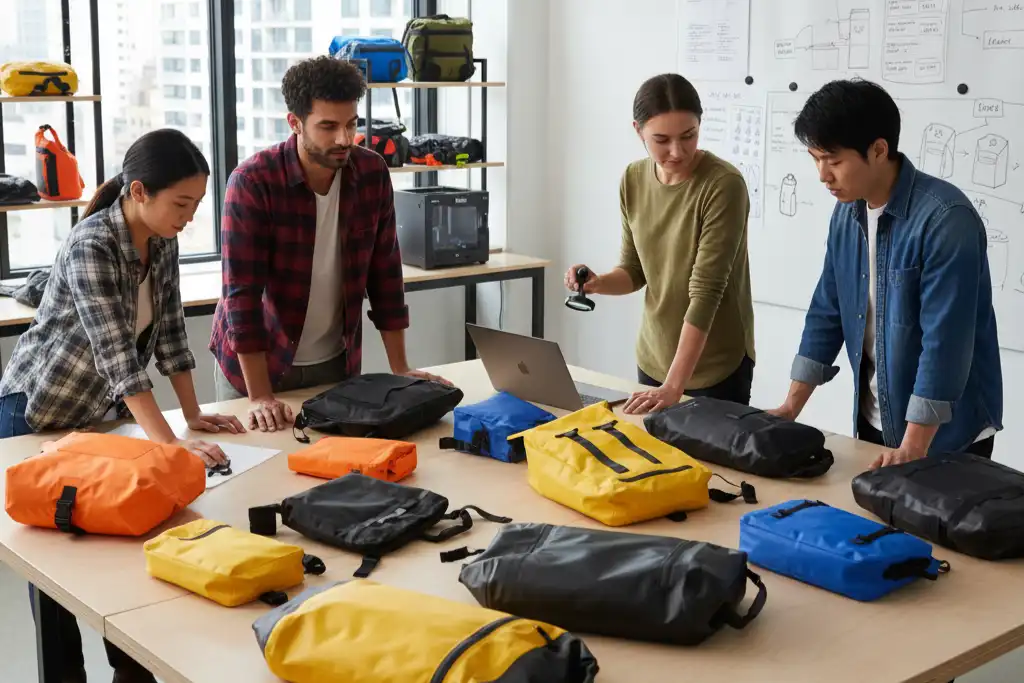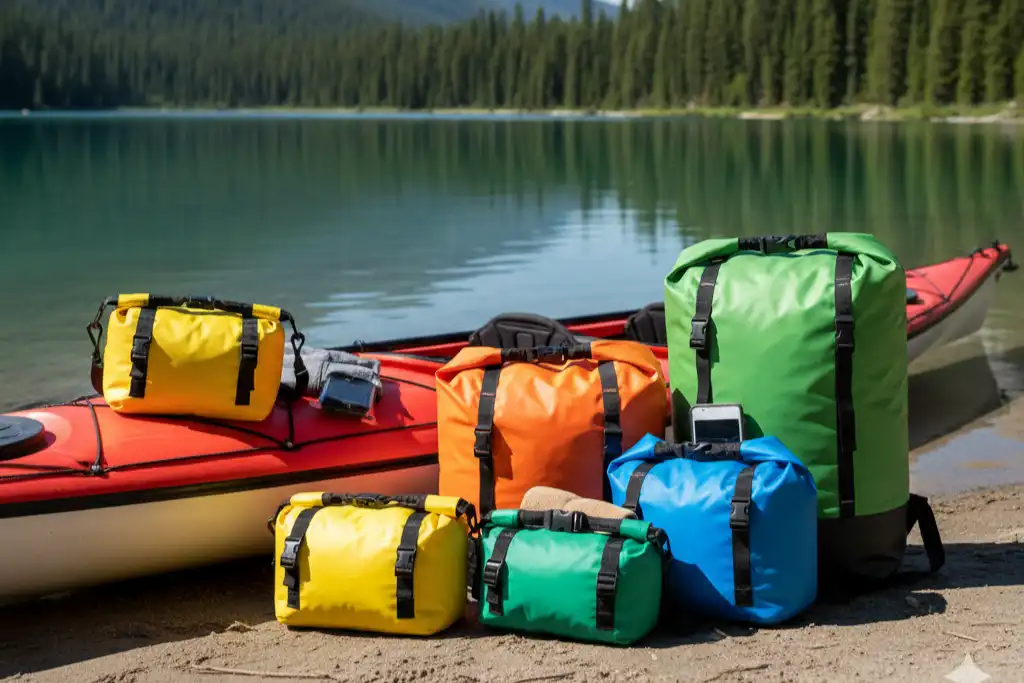What Is Dry Bag Technology and How Does It Work?

A Dry Bag uses special materials and closures to keep your gear safe from water. You place your items inside, seal the top, and the bag blocks moisture from getting in. You can depend on this bag when you go hiking, kayaking, or camping. It protects your valuables from rain, splashes, and even brief submersion.
Key Takeaways
- Dry Bags keep your things dry with waterproof materials and special closures. They protect your stuff from rain, splashes, and short dips in water.
- Pick the right Dry Bag for your activity. Different sizes and materials work better for kayaking, hiking, or camping.
- Roll-top closures and welded seams are important features. They make a tight seal and stop water from getting in. This makes Dry Bags better than regular waterproof containers.
- Compression features help you save space and keep things neat. Use compression straps to pack well for trips that last many days.
- Always check the waterproof rating and material before you buy. Take care of your bag by cleaning and drying it. This helps your bag last longer.
Dry Bag Technology Explained
What Is a Dry Bag?
A Dry Bag helps keep your things dry. It is a soft, waterproof bag with special seals and welded seams. The roll-top closure lets you squeeze out air and make a tight seal. Welded seams stop water from leaking through holes. Waterproof fabrics keep water from getting inside. These bags can handle water up to 1.5 meters deep. Your gear stays safe, even if you drop the bag in water.
Dry Bags are made from different materials. Each one helps block water and protect your stuff. Here is a table that lists the main materials and what they do:
| Material | Water Resistance | Durability and Other Characteristics | Applications |
|---|---|---|---|
| PVC Tarpaulin | Inherently waterproof | Tough against tears, holes, and scratches; easy to clean | Kayaking, boating, and other water-based activities |
| PU Coated Nylon | Durable water-repellent finish | Flexible, light, and breathes better than PVC | Hiking, camping, and lightweight backpacking |
| Dyneema® Composite Fabric | Waterproof and blocks UV rays | Light, strong, and eco-friendly; made from recycled stuff | Ultralight backpacking and tough outdoor trips |
| Nylon Ripstop | Can be treated with DWR coatings for water resistance | Hard to tear because of strong fabric; lightweight | Popular among backpackers and campers |
Dry Bags work better than old waterproof containers. The table below shows how they are different:
| Feature | Dry Bags | Traditional Waterproof Containers |
|---|---|---|
| Waterproof Level | Fully waterproof, even underwater | Only stops splashes or light rain |
| Sealing Mechanism | Advanced roll-top closures | Basic ways to close |
| Durability | Very strong and lasts long | Not always as tough |
| User Satisfaction | Usually higher because they work well | Often lower satisfaction |
Common Uses
People use Dry Bags for many outdoor activities. They use them to keep their gear dry and safe. Here are some of the most common uses:
- Paddleboarding
- Whitewater trips
- Kayaking
Dry Bags are also used for hiking, camping, and backpacking. They keep clothes, electronics, and food safe from rain, splashes, and drops in water. Dry Bags help when you travel in wet places or cross rivers. You can trust them to keep your things safe on adventures.
Tip: Pick a Dry Bag that fits your activity and gear size. You get the best protection when you choose the right material and closure.
How Dry Bag Technology Works

Waterproof Materials
You need to know what makes a Dry Bag waterproof. The answer lies in the materials. Manufacturers use special fabrics that block water from getting inside. Each material has its own level of waterproofness and best use case. Here is a table that shows the most common materials and their ratings:
| Material | Waterproofness | Waterproof Rating | Best Use Cases |
|---|---|---|---|
| PVC | Good | Above 5,000 mm | Water sports, outdoor work |
| TPU | Excellent | IPX8 | Kayaking, hiking in heavy rain |
| Ripstop Nylon | Good | N/A | Hiking, camping, travel |
| Polyester | Moderate | N/A | School, gym, daily use |
| PU-coated Nylon | Excellent | N/A | Outdoor, travel, sports |
PVC and TPU stand out for their high waterproof ratings. TPU can handle heavy rain and even submersion. PU-coated nylon also works well for outdoor trips. You should pick the material that matches your activity. If you plan to go kayaking or face heavy rain, TPU or PU-coated nylon will give you the best protection.
Roll-Top Closures and Welded Seams
The way you close a Dry Bag matters as much as the material. Most Dry Bags use roll-top closures and welded seams. These features keep water out, even if you drop the bag in a river. Here is how they work:
- Roll-top closures create a tight seal. You fold the top edge of the bag at least three times and then clip it shut. This method works well, even underwater.
- Welded seams use heat or radio frequency to bond the fabric. This process removes needle holes, which can let water in over time.
- Zippered bags need special zippers and sealing. These may not work as well as roll-top closures and welded seams.
Note: Most waterproof failures happen at the closure. Roll-top closures with at least three folds and a buckle clip set the gold standard. Welded seams form a permanent bond and do not break down. Many Dry Bags pass submersion tests at depths over 1 meter and meet IP67 or IP68 standards.
You can trust a Dry Bag with a roll-top closure and welded seams to keep your gear dry. These features work better than stitched seams or regular zippers.
Compression Features
Packing for a multi-day trip can be hard. You want to save space and keep your gear organized. Many Dry Bags come with compression features. These let you squeeze out extra air and make the bag smaller. Compression straps help you pack bulky items, like sleeping bags or jackets, into a tight space.
Lightweight materials make the bag easy to carry. You can fit more gear in your backpack and keep everything dry. Compression features help you stay organized and make packing more efficient.
Tip: Use the compression straps to shrink the bag after sealing it. This trick gives you more room in your pack and keeps your load light.
A Dry Bag with compression features helps you pack smarter and travel farther.
Dry Bag Features and Selection
Picking a Dry Bag depends on what you do. You need to think about your gear and what features you want. Knowing about types, sizes, closures, and extras helps you choose well.
Types and Sizes
Dry bags come in many shapes and sizes. Each kind works best for certain outdoor activities. The table below shows which type fits each use:
| Type of Dry Bag | Best For |
|---|---|
| Roll-Top Dry Bag | Kayaking, Hiking, Camping, Beach Trips |
| Zippered Dry Bag | Sailing, Boating, Jet-Skiing, Water Sports |
| Backpack Dry Bag | Hiking, Backpacking, Wet Environments |
| Duffel Dry Bag | Diving, Sailing, Expedition Travel |
| Compression Dry Bag | Backpacking, Camping, Compact Packing |
| Transparent Dry Bag | Quick Access, Photography |
| Submersible Dry Bag | Scuba Diving, Snorkeling, Whitewater Rafting |
| Insulated Dry Bag | Picnics, Camping, Food and Drink Storage |
| Multi-Compartment Dry Bag | Angling, Photography, Efficient Packing |
| Wet-Dry Dry Bag | Beach Days, Watersports, Rainy Adventures |
| Hybrid Dry Bag | Versatile Use Across Activities |
The size of your bag matters for each activity. The table below shows what size works best:
| Activity | Recommended Dry Bag Size |
|---|---|
| Kayaking or Canoeing | 20-30L (day trips), 50+L (weekends) |
| Hiking or Backpacking | 5-15L (day hikes), 20+L (multi-day) |
| Camping | 30-70L (gear needs vary) |
Tip: Don’t fill the bag too much. Leave space at the top so you can roll it three times for a tight seal.
Closure Systems
Closures keep water out of your bag. The roll-top is the most popular. You roll the top down a few times and clip it. This makes the bag airtight. Zippered closures are also used. They are easier to open but may let water in if the bag goes underwater.
- Roll-top closures: Best for keeping water out.
- Zippered closures: Simple to open, but not as waterproof.
- Special zippers (like TruZip or HydroLok): Seal well but can be harder to close.
People say roll-top closures and welded seams keep gear dry best, even when squeezed.
Extra Features (Straps, Pockets)
Extra features make dry bags easier to use. Many bags have straps you can adjust and wear like a backpack. Some bags have pockets for small things. Clear panels help you find stuff fast. Compression straps help you pack big items tightly. Bags with more sections help you organize your gear.
Note: Always check the waterproof rating and material before buying. Sharp things can poke holes, so use extra pouches inside for safety.
You now know what makes a Dry Bag a smart choice for outdoor adventures. These bags offer many benefits:
- Waterproof protection for your gear
- Strong materials that last for years
- Easy ways to organize and carry your items
You can keep electronics and clothes safe from water. Always pick the right size and check for strong seams. For best results, clean your bag with mild soap and let it dry fully before storing.
FAQ
What makes a dry bag different from a regular bag?
A dry bag uses waterproof materials and special closures. You get protection from water, rain, and splashes. Regular bags do not keep your gear dry in wet conditions.
What can you store in a dry bag?
You can store clothes, electronics, food, and important documents. Dry bags keep these items safe from water during outdoor activities.
What size dry bag should you choose?
Pick a size based on your activity. Small bags work for phones or wallets. Large bags fit sleeping bags or clothes. Always leave space to seal the top tightly.
What should you do if your dry bag gets punctured?
Patch small holes with repair tape or a patch kit. For large damage, replace the bag. Always check your bag before each trip.
See also
How to Choose the Right Waterproof Backpack for Outdoor Adventures
10 Features That Set the Best Outdoor Backpacks Apart
How to Use a Waterproof Bag for Emergency Purposes in The Wild



Comments are closed